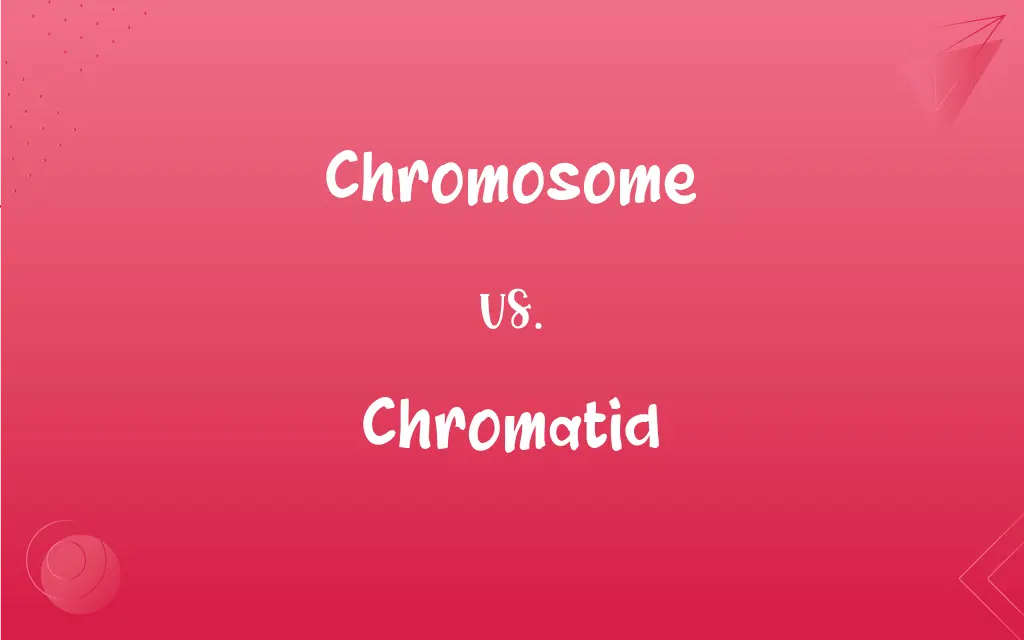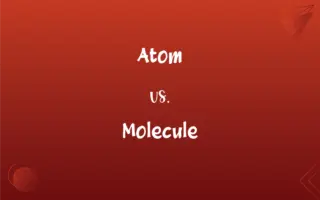Chromosome vs. Chromatid: What's the Difference?
Edited by Aimie Carlson || By Harlon Moss || Updated on August 10, 2024
A chromosome is a structure carrying genetic information; a chromatid is one of two identical halves of a duplicated chromosome.

Key Differences
A chromosome is a thread-like structure composed of DNA and proteins that carry genetic information. Each human cell, for instance, contains 46 chromosomes. In contrast, a chromatid refers to one of the two identical halves of a duplicated chromosome. When a cell is preparing to divide, its chromosomes duplicate, resulting in two chromatids connected at a point called the centromere.
Both chromosome and chromatid are fundamental concepts in genetics and cellular biology. Chromosomes are present in every cell, ensuring that genetic information is passed on during cell division. Chromatids, on the other hand, only become distinguishable as separate entities during specific stages of cell division. They play a crucial role in ensuring that each daughter cell receives an accurate copy of genetic material.
The relationship between chromosome and chromatid becomes particularly evident during the process of mitosis, a type of cell division. Before a cell divides, each chromosome replicates to produce two identical chromatids. During mitosis, these chromatids are separated, with each new cell receiving one chromatid from each chromosome.
It's essential to understand the distinction between chromosome and chromatid when studying genetics. A mistake in the separation of chromatids during cell division can lead to genetic disorders. Moreover, while all cells contain chromosomes, the appearance and number of chromatids change depending on the cell's stage in the division process.
In summary, while both chromosome and chromatid are related to genetic material and its transmission, they represent different structures and stages in the cellular lifecycle. A chromosome is a broader term referring to the genetic material in a cell, whereas a chromatid is specifically one half of a duplicated chromosome.
ADVERTISEMENT
Comparison Chart
Definition
Thread-like structure of DNA and proteins
One of two identical halves of a duplicated chromosome
Number in Human Cells
46 chromosomes (23 pairs)
Varies, 92 during stages of cell division after duplication
Connection Point
N/A
Connected to its duplicate at the centromere
Role in Genetics
Carries genetic information
Ensures accurate DNA distribution in cell division
Appearance in Cell Cycle
Present throughout
Visible as separate entities during specific stages
ADVERTISEMENT
Chromosome and Chromatid Definitions
Chromosome
A structure carrying genes in a cell.
Humans have 23 pairs of chromosomes.
Chromatid
Linked at the centromere.
The centromere holds the two chromatids together.
Chromosome
Carrier of hereditary information.
Studying chromosomes provides insight into heredity.
Chromatid
Separates during cell division.
Proper chromatid separation is crucial for genetic accuracy.
Chromosome
Units segregating during cell division.
During meiosis, chromosomes segregate to produce gametes.
Chromatid
Represents a replicated genetic copy.
Each chromatid carries the same genetic information as its twin.
Chromosome
Thread-like DNA-protein complex.
Each chromosome contains numerous genes.
Chromatid
Identical DNA copy in a chromosome.
Chromatids separate during mitosis ensuring DNA distribution.
Chromosome
Genetic material organizer.
Abnormalities in chromosomes can lead to genetic disorders.
Chromatid
One half of a duplicated chromosome.
Before cell division, each chromosome has two chromatids.
FAQs
How many chromosomes do humans have?
Humans have 46 chromosomes, arranged in 23 pairs.
When do chromatids become visible?
Chromatids are visible as separate entities during specific stages of cell division.
How does a chromatid relate to a chromosome?
A chromatid is one of two identical halves of a duplicated chromosome.
Are all chromosomes paired?
In diploid organisms, like humans, chromosomes exist in pairs. However, sex chromosomes may not be identical pairs.
Do all organisms have the same number of chromosomes?
No, the number of chromosomes varies across different organisms.
Can a cell have more than two chromatids for a chromosome?
Typically, a chromosome has two chromatids after replication, but errors can lead to more.
What role do chromosomes play in inheritance?
Chromosomes, carrying genes, determine the hereditary traits passed from parents to offspring.
Are all chromatids identical?
Yes, each chromatid is an identical copy of its twin in a duplicated chromosome.
Why are chromosomes important?
Chromosomes carry genes, the units of hereditary information.
What's the significance of the centromere in chromatids?
The centromere holds the two chromatids together until they are separated during cell division.
Can abnormalities occur in chromosomes?
Yes, abnormalities in chromosome number or structure can lead to genetic disorders.
What is a chromosome?
A chromosome is a thread-like structure carrying genetic information in cells.
At what point do chromatids separate?
Chromatids separate during mitosis, a type of cell division.
What holds chromatids together?
Chromatids are held together at the centromere.
What happens if chromatids don't separate properly?
Improper separation can lead to genetic disorders or cell death.
Are genes found on chromosomes?
Yes, genes are segments of DNA located on chromosomes.
How do chromatids form?
Chromatids form when a chromosome replicates its DNA before cell division.
Can chromosomes be seen under a microscope?
Yes, during certain stages of the cell cycle, chromosomes are visible under a microscope.
Can chromosome numbers vary across species?
Yes, different species have different numbers of chromosomes.
How do chromatids ensure genetic accuracy?
By carrying identical genetic information and separating properly during cell division.
About Author
Written by
Harlon MossHarlon is a seasoned quality moderator and accomplished content writer for Difference Wiki. An alumnus of the prestigious University of California, he earned his degree in Computer Science. Leveraging his academic background, Harlon brings a meticulous and informed perspective to his work, ensuring content accuracy and excellence.
Edited by
Aimie CarlsonAimie Carlson, holding a master's degree in English literature, is a fervent English language enthusiast. She lends her writing talents to Difference Wiki, a prominent website that specializes in comparisons, offering readers insightful analyses that both captivate and inform.
































































